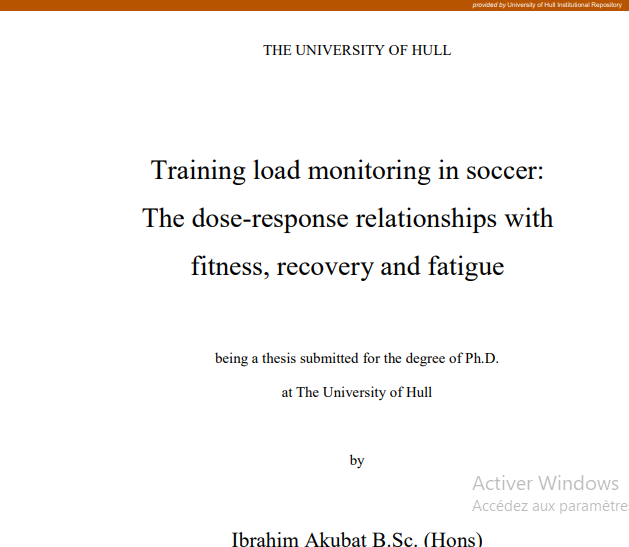The congested fixture schedules in elite soccer leagues around the world has bough the issue of recovery between games and subsequent performance to the fore in soccer related research.
Studies have described the time-course of recovery for numerous biochemical and physiological measures of performance, fatigue and recovery from match-play.
However, the research also suggests that there is individual variation in the external load both between players and between matches.
The external load measured as distance in match-play has been shown to vary by ~30% between games. However it is the internal training load that will determine the magnitude of the physiological responses on an individual basis.
Therefore the major aim of this thesis was to examine the dose-response relationships between measures of training load and the physiological and biochemical responses used as markers of recovery from match-play.
The thesis also assessed the relationships between these proposed markers of recovery and soccer specific performance.
In meeting the aims of the thesis a number of preliminary studies were conducted.
The study in section 3 assesses the extent of fixture congestion in the English Premier League.
The results showed over 30% of games for the most successful teams are played with 3 days recovery time, justifying the need for investigating recovery from soccer match-play. Given the variation in soccer match-play section 4 examines the reliability and validity of the modified BEAST90 soccer simulation.
A measure of performance with less variance would allow changes in soccer specific performance to be identified with greater certainty in section 7.
Section 5 assesses the influence of intermittent exercise on the blood lactate response. Given that the new iTRIMP method of measuring internal training load weights exertion with the blood lactate response it was important to assess the influence exercise mode may have on the calculation of 8 internal training load.
The results showed that at higher intensities intermittent exercise produced significantly higher blood lactate responses. Section 6 assesses the doseresponse relationships between training and fitness using numerous measures of internal training load over a 6 week training period.
The results showed only the iTRIMP method showed a significant relationship with changes in fitness. Section 7 assesses the dose-response relationships between exertion in soccer match-play and various physiological measures of fatigue and recovery.
The relationships between these measures and changes in soccer specific performance were also assessed. Finally the internal and external load were integrated and the relationships of this ratio assessed with measures of fitness and performance.
The results showed that changes in any of the physiological and biochemical measures used to assess recovery did not relate to changes in performance with the exception of testosterone whichn showed significant positive relationships with changes in distance covered from the 1st trial of the modified BEAST protocol to 2nd.
Testosterone also was the only measure to show a significant relationship during the recovery period with any measure of training load (sRPE).
Finally, the novel findings of this thesis is the relationships between the integrated ratio’s of internal and external training load with measures of aerobic fitness is also presented in section 7.

